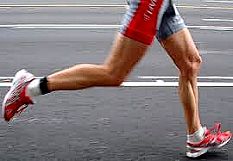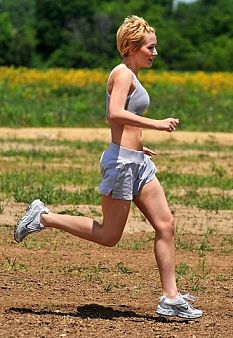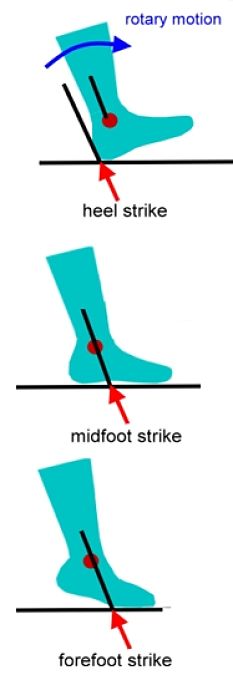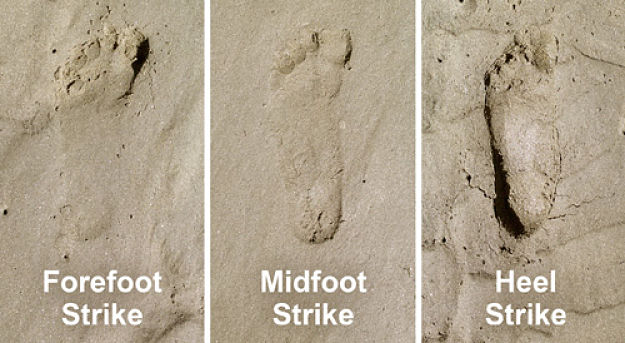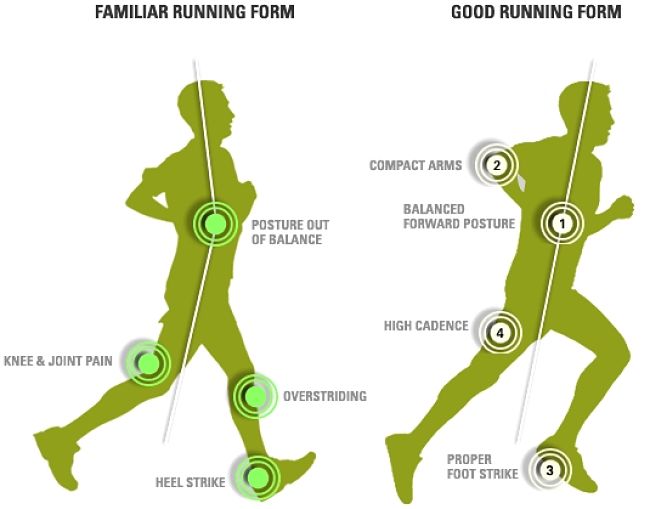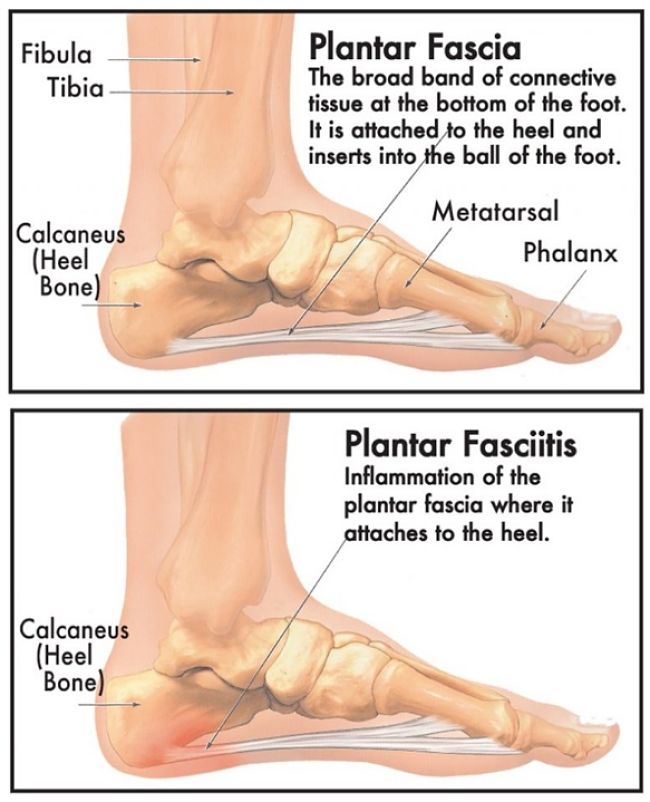Landing Heel First When Running Doubles Stress Injury Rates Causing Shin Splints, Foot Pain
There has been considerable debate recently about running style, barefoot running, natural and ancient running styles and whether or not, runners should land on their heel or forefoot. However, despite the debate and claims, there has been little research to back up the claims because of lack of information. A database of information from Harvard University’s collegiate cross country team provided an insight into the relationship between footstrike and relative injury rates. During the track and cross-country seasons, the team members entered their daily mileage and pace into an online training website monitored by the team’s trainers and coaches. Of the 52 runners in the team included in the study, 36 (60%) mostly used a rearfoot strike action, landing on the heels first, and 16 (30%) mostly landed on the forefoot first. The study found that there were significant differences in the rate of repetitive stress injuries (such as shin splints, foot pain and stress fracture symptoms) between the two groups. However, traumatic injury rates were not significantly different. The study found that repetitive injury rates were significantly correlated with strike type (foot position on landing) as a well as sex, race distance, and average miles run per week. The authors were quick to point out the findings only showed a correlation and did not establish a causal relationship. Runners troubled by regular injuries should examine their running gait and consider gradually changing their footstrike when running.
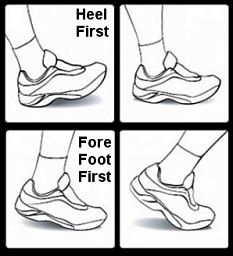
Foot-Strike Patterns
A study of foot-strike patterns of more than 900 distance runners at the 10 km of a road race found that about 90% were rearfoot strikers, 2% were forefoot strikers, 4% midfoot strikers. Interestingly, data for about 290 marathon runners showed that a large percentage midfoot and forefoot foot strikes at 10 km had switched to rearfoot striking at 32 km. Also the study showed no significant link between race times and foot strike patterns for the marathon runners. Stride length is also very important. This is overlooked by many runners.
Running Injuries
Previous review studies of injuries to runners have shown:
- no major differences in injury rates between men and women
- injury rate declined with years of running experience
- no increased rate of injuries with age on injuries
- strong link between previous injury on future injuries
- no substantial effect of height and weight or height
- training factor such as training frequency, speed, surface, timing had no effect on future injuries after taking distance run into account (more injuries per mile or km run)
- weekly distance is the strongest predictor of future injuries.
- Any recreational runners who have had injuries, particularly in the last 12 months were recommended to reduce their training to below 32 km per week, as a guide.
- Race competitors are advised to ensure that any prior injuries are sufficiently healed before future races, particularly marathons.
For the Harvard study, researchers measured the foot-strike characteristics of long and middle distance runners and compared statistics on their injury histories, including rates and type of specific injuries, the injury severity, and estimated the frequency of severe, moderate and mild injuries per mile run.
About three-quarters of the runners had at least one moderate or severe injury each year. Those who habitually adopted a rearfoot strike, landing on their heels first, showed double the rate of repetitive stress injuries compared with the runners who habitually showed forefoot strike, landing on the front part of their feet.
There was no significant differences in the rates of traumatic injuries.
Repetitive stress injuries are generally characterised by swelling and pain due to repeated stress from running and jogging during training and race activities causing foot and leg pain such as shin splits.
Symptoms range from vague, dull aching to sharp pain upon movement. Sufferers often missed practice due to aching muscles or over-stressed bones. Each of those injuries, no matter how small was reported by the runners and entered into the database and analysed.
Most runners strike the ground first with their heels, and modern running shoes are well-cushioned to cope with this action. There is a lot of debate about which foot-position is the more natural and this is related to the bare-foot running debate.
All runners in the present study wore shoes and so this study provides no insight into this debate, but it does suggest a relationship between foot strike patterns and injury rates.
No runner is strictly a forefoot striker or a heel striker. Form, gait and stride depends on many factors, including the terrain, speed, and how tired you feel.
Injury rates may also be related to shoe type and training regimes.
Some of the runners in the study ran in well-cushioned high quality shoes and became injured, while others wearing poorer quality shoes did not.
In general, runners who landed on their heels and hind-foot were much more prone to injuries in spite of the shoes they wore, or training regimes. Race distance
and miles per week was also correlated with injury rates.
So should the habitual heel-strikers change their form? The researcher cautioned that runners should not act unless they have problems with stress injuries.
They suggested that "If it’s not broke, don’t fix it.” If runners experience repeated injuries they should check their foot position when running and
slowly making changes. If runners were unsure of their strike pattern, they should get a friend videotape them running and use slow motion to determine which part of the
foot hits the ground first. The researchers cautioned that any changes should be done slowly and gradually, as making the change may itself cause injuries.
Many people who suddenly switch to barefoot running or to landing on the front part of the foot get injured. Change your running gait and form can affect
various parts of the leg and running efficiency.
The researchers suggest making gradual changes such as landing on the ball of your foot for about 5-10 minutes at first, during each run.
Most people show some variation in footstrike anyway, and so gradual changes should not be a radical change.
The researchers suggest gradually increasing the periods of landing on the forefoot during training as your body adjusts to the change.
The transition should be discontinued if the runner develops significant soreness. Give your body time to adapt to the changes.
The other alternative is that the heel striker could adjust their pattern more to the centre of the foot rather than completely shifting to the forefoot.
See this article.
The Rubik's Cube is not just a forgotten toy from the 80's. The fact is that it's even more popular than ever before.
Related Articles for Running and Injury Prevention
=> How Do You Stay Injury Free When Running, Training for Events
=> Best Tips for Jogging and Running with Dogs
=> Stretching Exercises Before a Run or Workout May NOT Reduce Injuries
=> Proven Benefits of Short, High Intensity Runs, Walks, Workouts
=> Tips for Running with Jogging Strollers: Pros and Cons, Stroller Holding Guides
=> How to Run Faster and Longer by Using your Magic Pace
=> Uphill Running Training Workouts and Intervals Plan for Speed, Endurance
